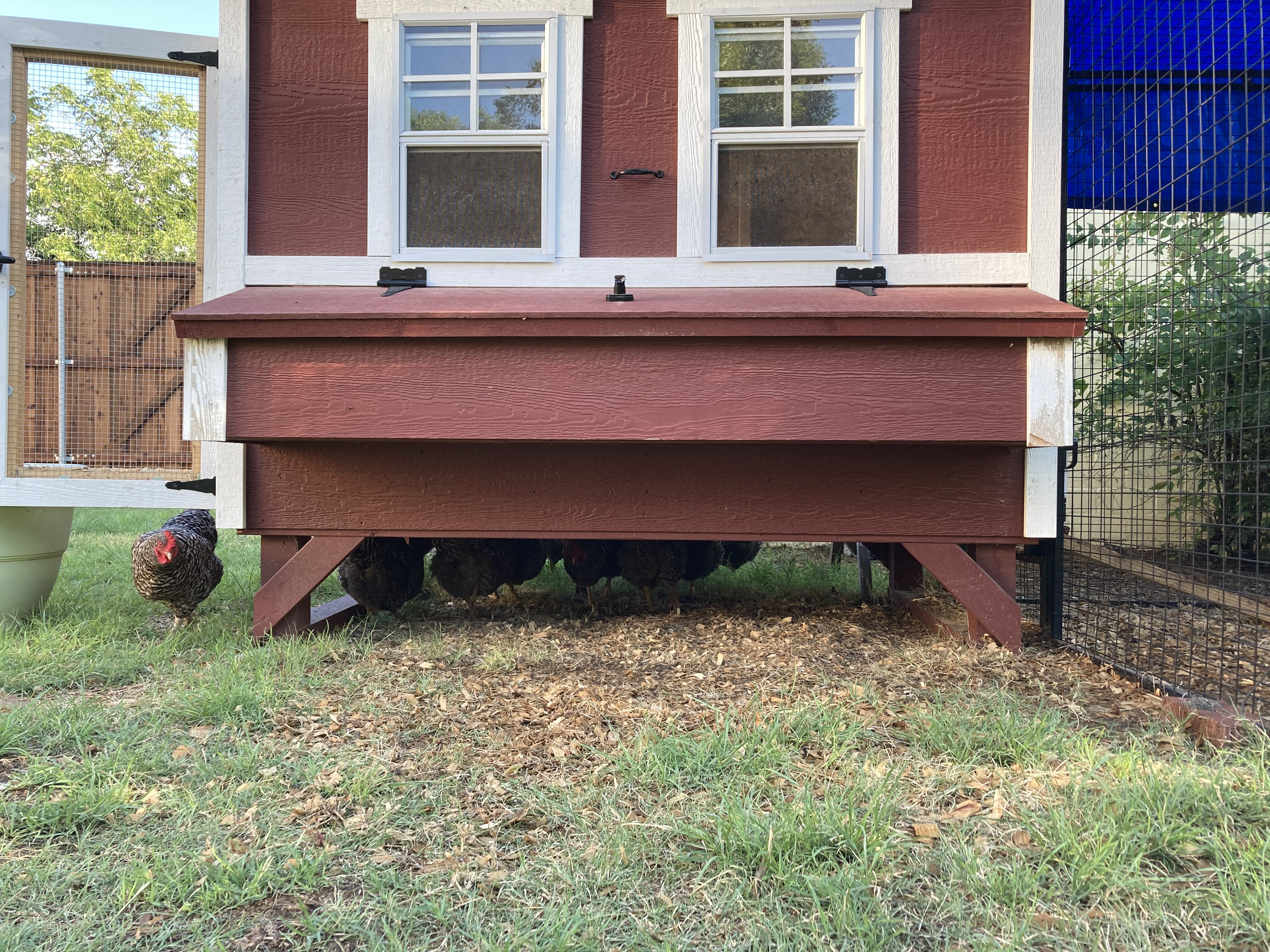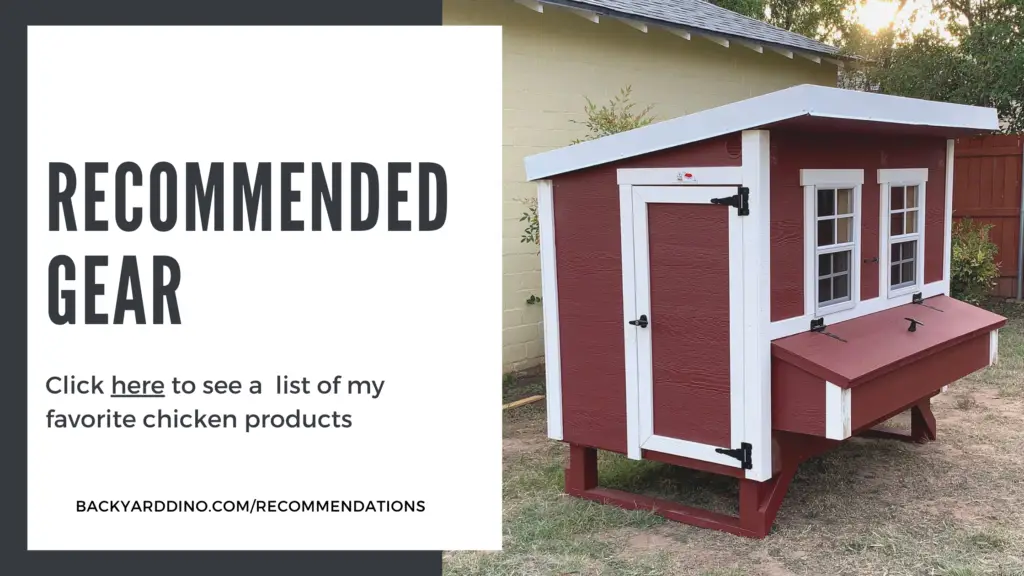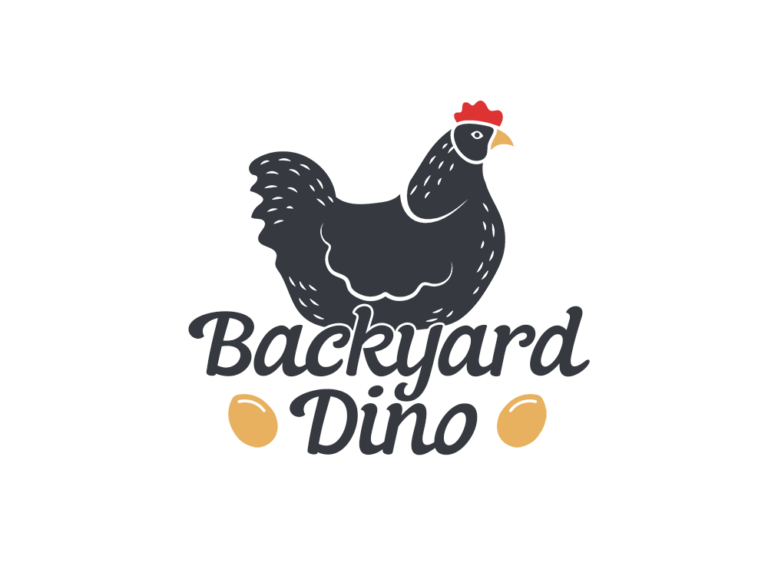Have you ever wondered why chicken coops are raised off the ground? Is it just because this looks cute or is there an actual reason behind why they are designed this way?
In general, chicken coops are designed to have the floor several inches above the ground to:
- Protect chickens from predators
- Allow air circulation around coop
- Prevent flooding during rain
- Provide a hiding spot for chickens
- Makes entering the coop easier for humans
- Helps when moving the coop
Keep reading to learn more about the benefits of having a chicken coop raised off the ground.
1. Protects Chickens from Predators
A chicken coop that is raised above the ground helps to protect the chickens from ground predators. Chickens are a prey animal so when you have a flock of chickens a large part of your responsibility is to protect them from predators that either want to eat them or their eggs.
Even if you live in a neighborhood, there are many ground predators that will eat chickens (or their eggs), including:
- Raccoons. Raccoons will eat anything chicken related: chicks, full-grown chickens, eggs, and their feed. They are capable of tearing chickens apart and will leave the feathers scattered around after they have eaten the carcass. Once a raccoon has found a good place to get a tasty meal, they will be back night after night. What’s worse, is that they teach their young so you can have several generations of raccoons to deal with if you don’t get them under control as soon as you realize they have found your chicken coop. Raccoons will eat eggs and might carry them off to finish eating them later.
- Skunks. Skunks are similar to raccoons given that they will eat chickens and their eggs. You can tell a skunk has been in your yard at night when you see several small holes dug throughout your yard the next morning (roughly the size of hole that could fit a golf ball). Skunks love to eat eggs.
- Opossums. Possums are more likely to attack chickens and maim them, with it being rare for them to kill the chicken. They will also eat eggs and might leave shells behind as a calling card.
- Dogs. Dogs are the worst when it comes to killing chickens indiscriminately, day or night. They can kill an entire flock in just a few minutes if they are given the chance. It’s not uncommon for dogs to kill chickens for sport, leaving the carcasses scattered throughout the yard. Dogs will also eat eggs if they find them.
- Least Weasels. Similar to dogs, weasels will kill chickens as a form of entertainment. Their kill instinct is triggered by movement, so if they make their way inside a chicken coop, they will attack and kill all chickens that run to escape them. Weasels can make entry into a coop through openings as small as 1 inch, so make sure any openings are covered with half inch hardware cloth.
- Snakes. A snake will most likely enter a chicken coop to eat eggs. Full-grown chickens are not something a snake is going to be interested in eating; however, if you have chicks a snake will easily swallow them. Make sure that wherever you keep your brooder with chicks that it’s snake-proof.
- Fox. Foxes will carry off chickens and eat their eggs. Foxes can climb trees and are known to be out and about during the day. Be careful letting your chickens free range if you live in an area that has foxes. Our neighborhood is very old with many house built in the 1920s to 1940s. We have a small stream in a park a few blocks away and have seen foxes in the neighborhood, even on our roof one morning!
- Rats. While you might not consider a rat as big of a threat as these other ground predators, they are capable of killing chicks and full-grown chickens alike. Rats can gnaw their way into a chicken coop and leave holes for other predators to enter, which is why half inch hardwire cloth is necessary for any openings in the coop since it would be virtually impossible for a rat to breach this wire. They are especially a problem if you leave out feed for the rats to eat, so check for their droppings around the feed storage and make sure to put up the feed in a secure location every night.
One of the common factors among these predators is that they can dig. For coops that are raised several inches above the ground, there is no where to dig in order to gain entry into the coop.
When a chicken coop is not raised from the ground, it will need to have a footer dug around the perimeter of the coop that has metal flashing or hardware cloth to prevent a predator from digging under the walls of the coop and gaining entry.
2. Allows Air Circulation Around the Chicken Coop
The inside of a chicken coop can get hot, especially if the coop is not under a tree or in the shade of another building. A chicken coop that is lifted several inches off the ground allows air to circulate around the exterior of the coop. This air flow is especially helpful in hot weather when there is a breeze.
3. Prevents Flooding of Coop During Rain
When it rains, the last thing you want is a flooded chicken coop or a poop swamp. By having the chicken coop above the ground, you are preventing flooding of the coop during rain.
Chickens don’t mind getting wet, in fact I have some chickens that seem to enjoy the rain and will stand in it. You will start to have a problem when the wet chickens get cold. If you live in a climate that gets a lot of rain during the fall or winter, you will need to take precautions that your chickens don’t get wet.
The chicken coop needs to remain as dry as possible to prevent a buildup of moisture and mold. Chickens have a sensitive respiratory system and excess moisture can lead to illness.
4. Hiding Spot for Chickens When They Free Range
A chicken coop that is several inches above the ground is a great hiding spot for chickens during the day.
The space under the chicken coop is shaded so it offers chickens a cool place to rest during the day. There can also be a cross breeze under the coop that can cool hot chickens.

In addition, a coop that is off the ground allows a place for chickens to escape aerial predators when they are out free ranging. Aerial predators of chickens include:
- Owls. Owls are more likely to attack chickens at the ends of the day, either at dawn or dusk. When an owl attacks a chicken, they will usually only leave a scattering of feathers on the ground.
- Hawks. Hawks, such as red tailed hawks and Cooper’s hawks, will eat full-grown chickens if the opportunity presents itself. Make sure your pullets have a place to hide from hawks. We recently saw a juvenile Cooper’s hawk attack a dove in our backyard, so it would be able to attack a young chicken as well.
5. Makes Entering the Coop Easier for Humans
The easiest chicken coop for humans to enter is a fixed location coop that resembles a shed or a child’s playhouse. These are typically built on the ground and often have full-size doors. The second easiest chicken coop design for a human to enter is a coop that is a few inches off the ground.
There are many reasons when you would need to enter your chicken coop, including:
- Cleaning the coop. Generally, you will want to do deep clean of the coop twice a year. Even if you don’t replace all the bedding (like if you used the deep litter method), you will still want to do a quick cleaning.
- Gathering floor eggs. Sometimes my chickens will either lay eggs directly on the floor of the chicken coop, or (more likely), the eggs will roll out of the nesting boxes and onto the floor. These eggs need to be gathered and trashed since they could have manure or other bacteria on them; otherwise, the eggs could rot or lead to chickens eating the eggs if they stick around inside the coop too long.
- Checking on chickens. If you have a hurt or sick chicken that needs to be inspected, it’s easiest to catch them when they are asleep on the roosting bars. It’s very helpful to have a coop that allows you easy entry to catch your chickens.
Another benefit of a small coop is that it’s easier to keep warm during the winter, unlike a larger coop that is the size of a shed. If you have a small coop but it’s on the ground, that would be like trying to crawl in and out of a dog house. When a small coop is raised off the ground, it makes it easier for us less agile humans to gain entry without falling on the bedding covered in chicken coop.
6. Helps When Moving the Coop
A raised coop is easier to move than a fixed location coop. A fixed location coop is build onto the ground and while it can be moved, it would be very difficult.
If you have a coop that is raised off the ground, you can move the coop by:
- Adding wheels to the coop (either 2 wheels on the front or back corners, or 4 wheels on all corners) and pushing to the new location
- Using a tractor to lift up the coop and repositioning it in the new location
Moving the coop can be a large undertaking, so it’s best to plan ahead for the best location prior to building the coop. Take a look at this post for more factors to consider when choosing your chicken coop.
As you can see, there are several benefits to having a chicken coop raised several inches off the ground. You don’t need it to be feet off the ground, but just enough so that your chickens are safe and have a healthy environment.


